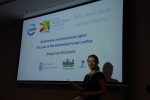 |
BESAFE at the IUCN World Park Congress: an interview with Dr. Malgorzata Blicharska
25.11.2014 |
 The IUCN World Parks Congress 2014 took place from 12 to 19 November 2014 in Sydney, Australia. As a landmark global forum on protected areas, the Congress was aimed at sharing knowledge and innovation, setting the agenda for protected areas conservation for the decade to come. Building on the theme "Parks, people, planet: inspiring solutions", it presented, discussed and created original approaches for conservation and development, helping to address the gap in the conservation and sustainable development agenda. The IUCN World Parks Congress 2014 took place from 12 to 19 November 2014 in Sydney, Australia. As a landmark global forum on protected areas, the Congress was aimed at sharing knowledge and innovation, setting the agenda for protected areas conservation for the decade to come. Building on the theme "Parks, people, planet: inspiring solutions", it presented, discussed and created original approaches for conservation and development, helping to address the gap in the conservation and sustainable development agenda.
Dr. Malgorzata Blicharska from the Swedish Biodiversity Centre (CBM) represented BESAFE at the Congress. Learn more about what happened at the Congress and how the project was presented from the following interview with Dr. Blicharska.
1) How did BESAFE contribute to the IUCN World Park Congress?
I was presenting one of BESAFE cases, the Białowieża Forest conflict case, at the Workshop in the stream on enhancing governance of protected areas, under the topic: Governance and procedural rights: securing collective responsibilities and citizen oversight in conserving nature. The workshop focused on the rights to access to information, justice and participation; in other words it was about qualities of good governance.
The presented case of the Białowieża Forest has exemplified that in a conflict situation, the particular arguments for conservation may not be sufficient, but also proper governance mechanisms that enable open, accountable and respectful participation are necessary. The workshop discussion underlined the importance of trust building for increasing the effectiveness of conservation and the need for using communication strategies tailor-made for particular context. This resonates well with the general findings from the BESAFE case studies (see Deliverable 2.3).
2) Tell us a bit more about other BESAFE relevant topics and trends discussed at the Ccongress?
There was a wide array of topics that are very relevant for BESAFE. In general, the Congress discussions underlined that while we are on the right track to achieve conservation targets, there is still a large need to ensure better conservation and management of areas important to biodiversity and ecosystem services. Economic benefits and cost-effectiveness of conservation were key areas of discussions. It looks like the appreciation of the value of nature for delivering different benefits to humans is increasingly recognized as important. As Ms. P. Caballero from the World Bank said: “When we erode nature, we are actually eroding human well-being”. An important service that was particularly often mentioned was climate mitigation. Protected areas were seen as one of solutions to the climate change problem.
Other discussions very relevant for BESAFE were focused on the ways to communicate the importance of nature and its conservation. It was underlined that telling stories is a good way of engaging people. According to Thomas Friedman, the New York Times journalist: “People relate to people and people relate to stories”, thus stories adjusted to particular audiences should be used to encourage pro-environmental thinking. Also communication through new technologies was seen as great opportunity to create more social awareness.
3) Which will be the emerging/new areas/challenges/questions regarding protected areas conservation?
At the Congress there was an great emphasis on the importance of young people for the future conservation efforts. New generation of young people engaged in environmental issues creates opportunities for conservation. They are also a specific group for which a particular set of arguments should be delivered in modern form. I think future argumentation research need to address the ways of communication with the youth.
Overall, the Congress was an impressive venture, where people from different countries, with different backgrounds, representing different organizations and various governance levels exchanged ideas, challenged each other and search for common solutions. A multitude of arguments were used, ranging from very economic ones to the less tangible ones, relating to human cultural values and emotions. As a renowned photographer, Adrian Steirn said: “You do not kill what you love (…) We do need to care about our world”.
| | all news » |
|
|
 |
|